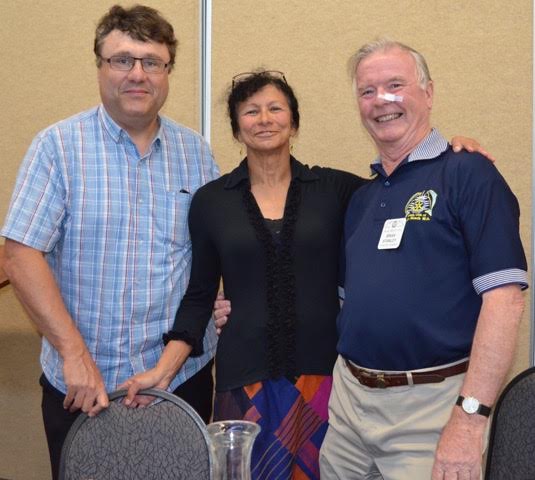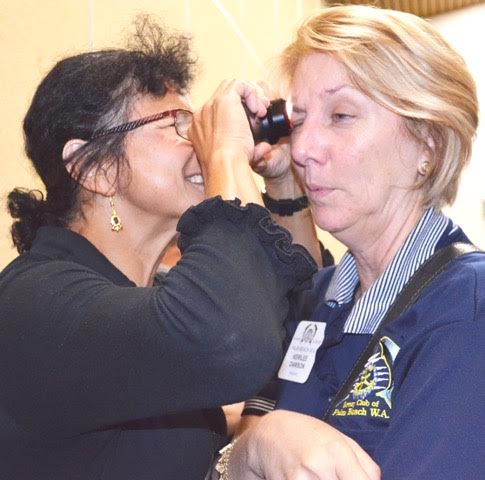
Rockingham GP and dermatologist Dr Renuka Ranasinghe (centre) with husband Paul and her Rotarian patient Brian Stanley.
ROCKINGHAM GP and dermatologist Dr Renuka Ranasinghe diagnosed one squamous cell carcinoma after talking to Palm Beach Rotarians on Wednesday night. She also suggested other lesions should be followed up. Dr Ranasinghe came to the meeting with her husband Paul, “a technical wizard” who kept confronting images of various skin cancers coming during her talk. She also came equipped with a dermatoscope — a small instrument which emits polarised and non-polarised light and magnifies skin lesions — and invited Rotarians to have their lumps and bumps checked after her talk. A considerable number took up her offer.

Kerilee Dawson getting some expert advice
The dermatoscope’s polarised light allows her to see deeper skin structures — she can see veins below the skin, Dr Ranasinghe said.
The non-polarised light provides information about the superficial skin. Dr Ranasinghe toggled between the two modes to get complementary information about lesions. During her talk, she urged Rotarians to check themselves and their partners and other family members for skin changes. “I check people all the time,” she confessed. “I will even check them in supermarket queues.” If she is worried by what she sees, she will urge her fellow queuers to get their spots, keratoses or whatever checked by a doctor. People should look out for new lesions or changes to old lesions. “If there is a loss of symmetry in the perimeter of a mole, get it checked,” she said. Half of the skin cancers she treated came from new lesions and half from old lesions that had changed. Dr Ranasinghe was introduced to the meeting by club member Brian Stanley, from whom she has been removing a succession of skin cancers. Brian is a huge fan and told the meeting that the GP/dermatologist/surgeon was a good friend who had saved his life. She had a hard life early on, suffering both gender and racial discrimination, Brian said. But she was a brilliant and committed doctor.
She said people with fair skin — especially those who freckled and sunburnt easily, or became red and painful in the sun — were most at
risk of skin cancer. People with blond or red hair and blue or green eyes were also at high risk. And so were people who had at least one severe sunburn early in life and those with chronic skin damage over the years. People with certain genetic disorders and numerous moles, unusual moles, or large moles that were present at birth were also at higher risk.
Solar or actinic keratoses (AK) — dry, scaly patches or spots — should not be ignored. They are precancerous growths and can progress
to a type of skin cancer called squamous cell carcinoma (SCC). Treatment is important.
Basal cell carcinoma (BCC) is the most common skin cancer, DrvRanasinghe said. It is caused by sun damage and she saw lots of BCCs on noses and ears but they also occur neck, and arms — anywhere on the body.
A basal cell carcinoma usually looks like a raised, smooth, pearly bump on the sun-exposed skin of the head, neck, or shoulders. Other signs include small blood vessels visible within the tumor and a central depression with crusting and bleeding (ulceration) frequently develops. A BCC often appears as a sore that does not heal.
Squamous cell carcinoma is usually found on parts of the body damaged by UV rays — the head, neck, ears, lips, arms, legs, and hands. It is a fairly slow-growing skin cancer but can spread to the tissues, bones, and nearby lymph nodes, where it may become hard to treat. When caught early, it’s easy to treat.
Melanoma is the most serious type of skin cancer. Melanoma frequently develops in a mole or suddenly appears as a new dark spot on the skin. But it is not always dark, it may be different colours, she said.
Melanomas are usually caused by DNA damage resulting from exposure to ultraviolet light from the sun. Genetics also play a role.
A weakened immune system makes it easier for cancer to arise due to the body’s weakened ability to fight cancer cells.
Dr Ranasinghe’s illustrations of tumours and wounds after surgery hammered home the need to be sun safe and to check skin for changes.